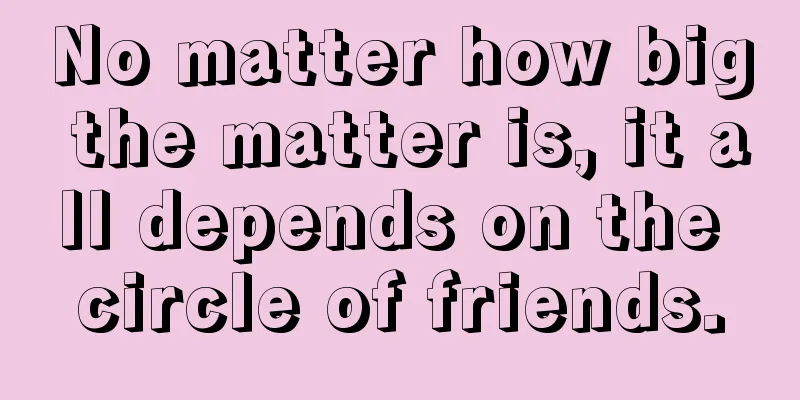How to highlight brand personality and gain more fans?

1. What is brand personality?Suppose there is a male colleague who has just joined your team. He always has long hair and dresses like a weirdo. As you get to know him better, you find that he is a humorous and easy-going person. After that, he becomes friends with everyone in the team. In the summer, he often treats everyone to beer and barbecue. In fact, brands also need to become this kind of "friend" of the target group: have memorable and distinctive characteristics that can make people associate positive emotions... What is Brand Personality?
We can actually conclude that brand personality is the manifestation of the personality of the brand after it is personified. So what is a person's personality? In psychology, personality refers to the internal stable factors of a person, the consistency of an individual's behavior in different situations, and the difference in behavior from others in the same situation. There is a key word: unique. Therefore, brand personality is the highest level in brand management. Brand personality refers to the communication of product or brand characteristics and consumers' perception of these characteristics based on this. It is the result of communication between brand managers and consumers. What is important is that brand personality can reflect the image of the brand user, embody the consumer's values, life goals, lifestyle, social status, etc. Brand personality is formed based on contact with consumers and is a collection and refinement of the brand user's personality. 2. What is the value of brand personality? .Shaping brand personality is the top priority of brand building and brand management, because brand personality is the core of the brand. The so-called brand has value and is the most valuable intangible asset of an enterprise. This is because although the products are produced by the enterprise, the brand is created by consumers and exists in the minds of consumers. In the eyes of consumers, a brand not only represents a certain product, but is actually a psychological phenomenon of consumers. People will not accept everyone in life because their psychological space is limited. Therefore, the more distinctive a brand is, the easier it is to stand out. Similarly, consumers will not accept all brands. They have preferences and only accept brands with the personality they recognize. Only brands with a personality that consumers like can be accepted, liked and willingly purchased by consumers, thus reflecting their brand value - therefore, brand personality is the core of brand value, and to enhance brand value it is necessary to create a distinct brand personality. Generally speaking, brands have:
3. Brand creative guidelines help build brand personalityThis is where a brand creative guide can help you, but it’s important to understand that a brand creative guide is not the same thing as a brand style guide. The style guide defines the image and look of the brand (my colleague has long hair and dresses like a geek), while the brand creative guide details how the brand touches people's various senses (the summer heat reminds me of his kebabs). While a style guide describes more technical specifications, such as logo size and color, a creative guide is designed to appeal to all of your audience’s senses and determine what feelings your brand should evoke. A brand creative guide is a set of defined creative specifications that apply to all presentation situations and explain how your brand identity should be creatively represented. No matter where your brand appears, whether you are running online advertising, planning in-store displays, running social ads or launching other forms of promotional activities, brand creative guidelines can ensure that your brand identity is authentic, pure and inspiring. With creative guidelines, your brand identity can remain consistent despite social and cultural changes. Let’s say your brand is known for being “masculine.” If society’s perception of masculinity changes, your brand design will evolve, but your brand identity will remain the same. Most importantly, creative guidelines help those who produce marketing materials, such as advertising agencies, suppliers, and internal teams, understand your brand identity and know how to shape your brand identity. This is important because the more these agencies or teams know about your brand, the better they can help you build an outstanding brand. IV. A Case StudyAxe, a global men’s grooming brand, developed a creative guide to keep pace with the times and align its brand identity and strategy. A decade ago, Axe’s creative strategy revolved around how to give men an edge in dating, with the brand’s famous ads featuring attractive women and “masculine men” as characters. As time went by, society’s view of masculinity changed and became more diverse. Men began to pay attention to personal care and use men’s grooming products to better express their charm. Axe realized that they also needed to change, but its iconic brand identity could not change. Axe’s creative guidelines played a key role in this change, helping Axe stay true to its brand identity of “masculinity” while exploring newer and more contemporary ways to interpret this identity. Axe took a new approach: there is no set definition of masculinity, and updated its creative guidelines to do so. Based on this change, the company showcased attractive men from various industries in its new advertisements. With the slogan "Discover Your Own Charm", the company encouraged men to discover their own uniqueness, while promoting the idea that using Axe products can help men show their unique charm. This is also a strategy. In fact, it is to redefine the brand personality based on the brand positioning. The brand communicates from the customer's perspective. Only when the brand positioning is determined can the brand personality be determined. 5. How to Create a Creative GuideSo, how do you create a brand creative guide? First, you need to create a brand identity. That is to say, first of all, you should clarify the brand vision and brand goals, and determine the target audience. At the same time, you should also find a series of adjectives, such as kind and considerate, generous, youthful, natural and authentic, to describe the brand personality. These adjectives represent the personality qualities of the brand, giving the brand humanistic traits, ideals, aspirations and value pursuits - all of which are more likely to impress people and attract customers. Once you’ve identified your brand traits, you need to think of synonyms that relate to those personality traits. For example, if one of your brand traits is “powerful,” you might think of synonyms like: competent, convincing, authoritative, energetic, etc. By using these synonyms, the creative guide can help you define which qualities represent your brand identity and which do not. “Competent” and “convincing” may be too weak, while “authoritative” is too strong, and “energizing” may be the most appropriate. It may be helpful to convene the people responsible for designing brand identity, such as designers, marketing personnel, public relations managers, etc., to conduct an internal brainstorming session and list relevant synonyms. After listing the synonyms, you need to connect the brand with the five senses of human beings and continue to give the brand human substance. People experience the world through each of their senses. Therefore, if a brand can impress every sense of the target audience, they will remember it more deeply and feel that the brand has more connotations. But what if the product isn’t something people can smell or eat, like perfume or food? This approach still works because all the senses have connotations that fit with your brand identity. You just have to make a hypothesis about your brand. "If my brand of sports car had a smell, it would be spicy. If it had a particular fragrance, it would be a pleasant new car smell." To connect your brand to the five senses, start with each of the five senses: sight, touch, smell, hearing, taste, and think about how your brand connects to each of these senses to make it unique. 1) Vision Think visually and find color schemes, photos, and illustrations that represent your brand. In other words, set visual standards that reflect your brand identity. Let’s say your brand identity is “casual”, then non-posed, everyday photos will be able to show your brand identity, while photos that are obviously posed will not be suitable. 2) Touch Think about the feel of your product and describe its appearance and texture. How does the packaging feel? If you were to open a pop-up store, what materials would you use? What kind of tactile sensation do you want your product to have? Think about whether your product is heavy or light? Is the surface smooth or rough? 3) Sense of smell From an olfactory perspective, it is extremely important to describe the unique smell of your product because smell is the most subconscious way to trigger emotions and is the easiest to remember. Does your product smell musky, floral, or sweet? 4) Hearing From an auditory perspective, designing a unique voice for your brand will help copywriters write copy that sets the tone of your brand. Ask yourself, if you were to hire a voice actor, what kind of voice would you want him to have? What kind of music would complement your brand? 5) Taste Finally, consider the taste. Suppose your brand's main product is a kind of food, what does this food taste like? Is it sour, sweet, or spicy? Can these foods make people think of your brand? When you hold an event, what kind of food will you use to entertain guests? Do you know how to create a creative guide? Then come and create your creative guide to highlight your brand personality and attract more "die-hard fans". 6. Some Principles
at lastWhenever it comes to "brand", we must remember: Brand is user thinking, and brand is formed in the user's mind. Returning to the brand personality, we must remember that the most attractive person in the crowd is always the one with a unique personality. This personality is not just about clothing, appearance, and behavior, but the unique personality behind it. However, we should note that personality is too difficult to understand, but personality guides behavior, and behavior can reflect personality, which needs to be viewed dialectically. Otherwise, when inappropriate behavior is inconsistent with the personality being promoted, people will think it is split, and credibility will be significantly reduced. The shaping of brand personality belongs to the brand building part of brand growth. Brand growth is a series of processes. Please refer to "2023 New Brand Growth Methodology" and "Brand Building Quick Guide". |
>>: Top 10 Breakout Cases in the First Half of 2023
Recommend
What makes Sam's Club and other chain stores keep lowering their prices?
This article delves into the current status and ch...
Millions of people check in to enjoy the hustle and bustle of life. Will live streaming + setting up stalls be a new business?
Have you ever watched live broadcasts of night mar...
Who will benefit if Taobao gets involved in MCN?
Guided by the strategy of revitalizing e-commerce,...
Fang Wenshan talked about how to write advertisements
Music has the power to touch the soul. Vincent Fan...
How to solve the problem of Amazon buyer account being blocked? What is the reason?
Generally speaking, the risk of Amazon's selle...
What should I do if my Amazon store is linked? What does it mean when a store is linked?
When you open a store on Amazon, if you find that ...
What does Amazon sales do? What are the operations tasks?
E-commerce is changing all the time, so there is n...
Is Shopee commission-free in the first few months? What are the store opening policies?
Shopee now has sites in many countries around the ...
What does Amazon ad group mean? What is an ad portfolio?
If Amazon merchants want to promote their products...
What are the free cross-border e-commerce platforms? Detailed introduction
Cross-border e-commerce platforms have sprung up l...
Is it true that cross-border e-commerce scams can lead to losing all your money? What scams are there?
The cross-border e-commerce market is still mainta...
Is the smoke of war coming for 618? Taobao and JD.com are overloading their military training
There is still more than a month to go before the ...
Is the money spent by brands on skit marketing worth it? A set of data can help you quickly sort out your thoughts
As an emerging marketing method, short drama marke...
Please answer | WeChat 2023: small steps and fast progress, big opening and closing
The war on the Internet has never stopped. As time...
Overcoming @一笑倾城, "Electronic Girlfriend" becomes the new top streamer on TikTok
Now, Douyin has become an app that everyone cannot...









